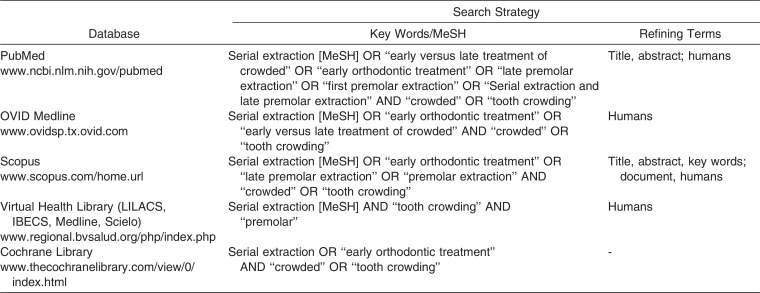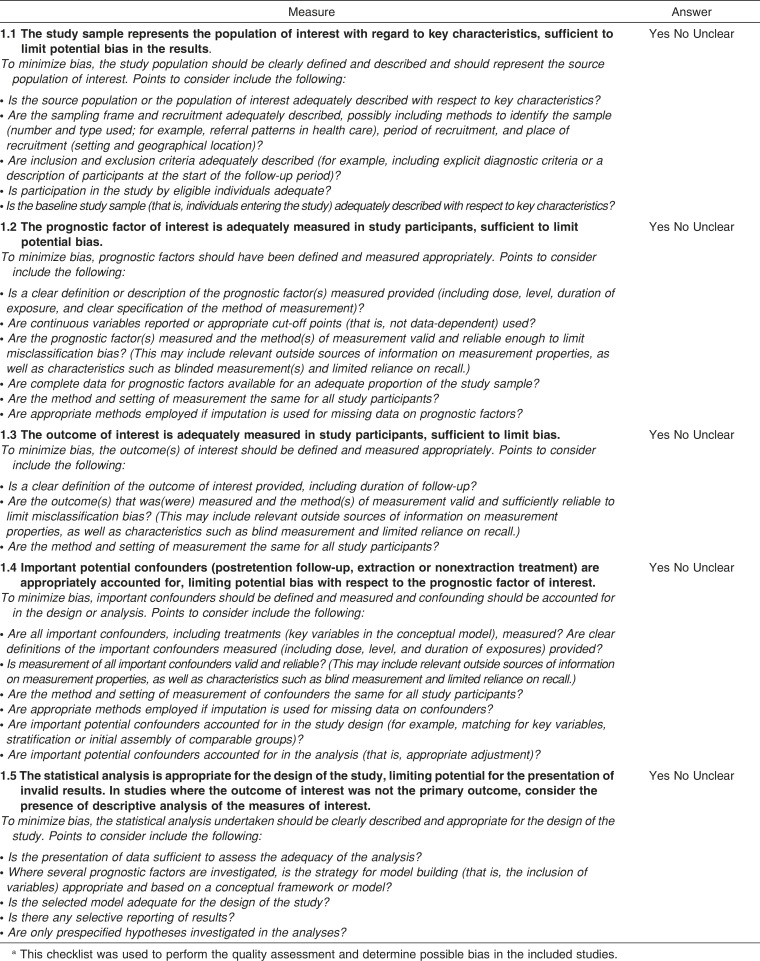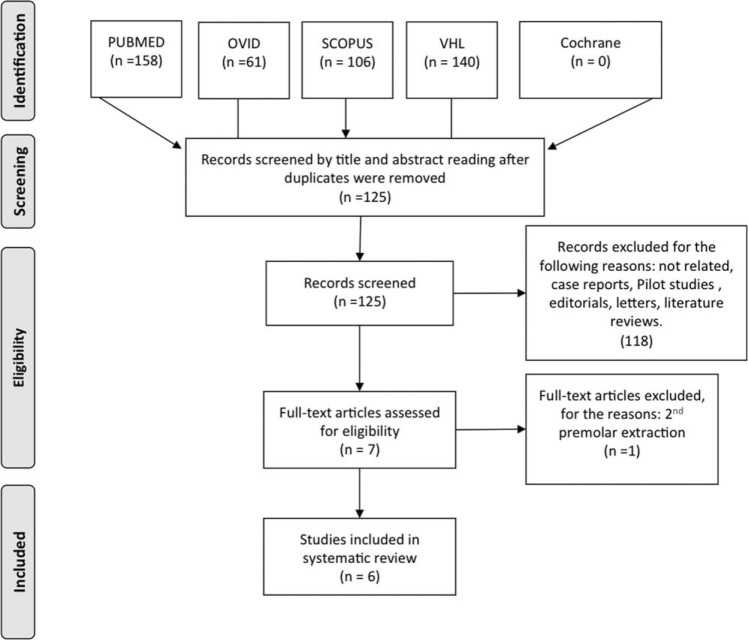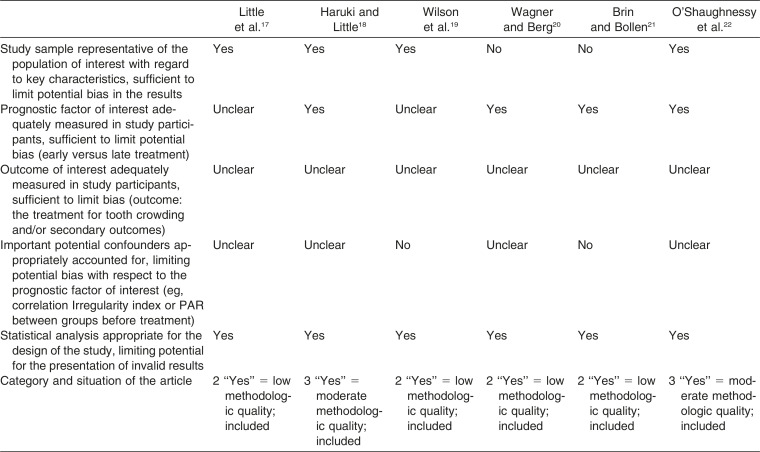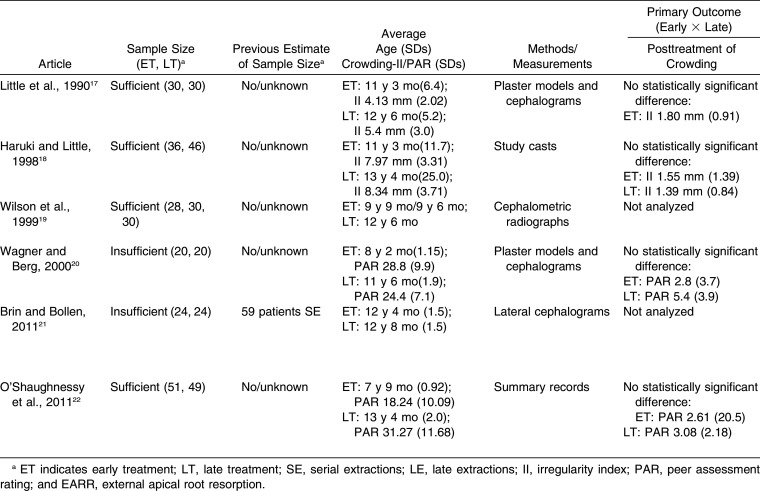Abstract
Objective:
To investigate the body of evidence in the literature about the most favorable time for initiating orthodontic treatment in patients with severe crowding caused by tooth size arch length deficiency (TSALD).
Materials and Methods:
Electronic databases (PubMed, Ovid Medline, Scopus, Virtual Health Library, and The Cochrane Library) were searched for articles published between 1900 and April 2014. Studies were included that evaluated treatment of patients with severe crowding caused TSALD, who were treated with first premolar extraction. The association between the stage of development of occlusion at which treatment was started, and the primary and/or secondary outcomes of early and late treatment were investigated.
Results:
After application of the eligibility criteria and reading of the full texts, six articles were included in the final review. Of these six articles, all of which were retrospective, four showed that the primary outcome (correction of severe crowding) of the early and late groups was improved, but without statistically significant differences after treatment. Therefore, the findings of secondary outcomes in the literature (postretention crowding relapse, duration of total and active treatment [treatment with appliances], external apical root resorption, and soft tissue profile) were the target of this study. These studies presented low or moderate methodological quality and control of bias.
Conclusions:
Both early and late extraction had a similar effect on correction of crowding. Early treatment had two favorable secondary outcomes (less relapse and reduced active treatment time) vs late treatment. However, the levels of evidence were not sufficient to assert which protocol was superior. (Angle Orthod. 2015;85:510–517.)
Keywords: Tooth crowding, Serial extraction, Early treatment, Early and late treatment
INTRODUCTION
The appropriate therapy for dental crowding varies according to the magnitude of the problem. According to Little et al.,1 this therapy may involve follow-up to develop and correct the occlusion. However, this is not always the case, and correction may occur spontaneously in patients with slight crowding (up to 2 mm); cases of severe crowding (>9 mm) may require more extensive therapy with tooth extractions.
Severe crowding caused by tooth size arch length deficiency (TSALD) may be treated at an early stage with serial tooth extractions in the early mixed dentition (first transitory period) or with late extraction of the premolars in the permanent dentition. The classic procedure of early treatment with the protocol of serial extractions has involved removal of the primary canines and finally; followed by later removal of the permanent the first premolars. Therefore, the goal of extraction in both time intervals is to create space to enable the correct alignment and leveling of the teeth in basal bone.2–4
The ideal time for the beginning of orthodontic treatment has always been a subject of controversy; the factors that most frequently favor early treatment are that it is easy to perform, and its cost, duration, and stability are better vs late treatment.5 This was also the opinion of 159 orthodontists of the American Board of Orthodontics, who said that treatment performed at an early stage enables improved control of growth; increases the patient's self-esteem and parents' satisfaction; presents better and more stable results; diminishes the extent of treatment needed for the permanent dentition, when necessary; and causes less damage to the periodontal tissues and tooth enamel.6
Many authors7–12 have written about the subject expressing the same optimistic trend toward early treatment with regard to clinical efficacy, reduction in mechanotherapy, and increase in stability. However, their affirmations were based on professional experience and case reports only. Therefore, by means of a systematic review, the aim of this research was to answer the following focused question: For patients with severe crowding caused by TSALD, are the occlusal and secondary outcomes of treatment with early first premolar extraction equivalent to those obtained with late treatment?
MATERIALS AND METHODS
To answer the focused question, this systematic review was performed in accordance with the PRISMA (Preferred Reporting Items for Systematic Reviews and Meta-Analyses) guidelines (www.prisma-statement.org)13 and registered with the number CRD42014009006.
Study Selection Criteria
The following criteria were formulated to select articles for inclusion in this review. All randomized clinical trials (RCTs) and human clinical trials with a prospective or retrospective design that evaluated treatment of patients with severe crowding caused by TSALD of both genders and of different social and racial groups (Participants) were chosen. All patients were treated with first premolar extraction (Intervention). All studies must have evaluated the association between serial extraction and late premolar extraction (Comparison) and reported on the primary (occlusal) and/or secondary outcomes (Outcome). Any studies that evaluated the beginning stages of treatment and outcomes but did not compare them were excluded from this systematic review. Furthermore, case reports, pilot studies, editorials, letters, and literature reviews were also excluded from the sample.
The outcomes were divided into primary (related to correlation of severe crowding, alignment, and leveling of teeth in basal bone) and secondary (according to the findings in the literature).
Search Strategy and Screening of Articles
To identify relevant studies, irrespective of language, a detailed search was conducted in the following electronic databases for papers published between 1900 and the first week of April 2014: PubMed, Ovid, Scopus, Virtual Health Library, and The Cochrane Library. The key words and Medical Subject Headings (MeSH terms) were modified to conform to the rules of each database (Table 1).
Table 1. .
Electronic Databases and Search Strategy Used
Two independent authors evaluated the titles and abstracts of all articles separately. Disagreements between the authors were resolved by discussion to reach a consensus. In case of persistent disagreement, a third author was consulted to arrive at a consensus. If the abstract did not provide sufficient information for a decision on inclusion or exclusion, the complete article was obtained and reviewed before a final decision was made.
Data Extraction
The methodologic checklist for prognostic studies14 developed by the National Institute for Health and Clinical Excellence of the United Kingdom in 2009 was adapted by the authors to evaluate the quality of included studies and control of bias (Table 2). For adaptation, the exclusion of item 1.2 (about the loss of follow-up), was proposed, because all included studies were retrospective and therefore this item was not applicable. The items of the checklist are written in such a manner that the answer “yes” always indicates that the study was conceived and conducted to minimize the risk of bias for this item. An answer of “unclear” to a question could arise when the answer to an item is not related or is not related in a clear manner. Studies were classified as being of high methodologic quality and low risk of bias if all five parameters received an answer of “yes,” moderate methodologic quality if at least three of the parameters received a reply of “yes,” or low methodologic quality if two or fewer parameters received an answer of “yes.”
Table 2. .
Adapted Methodologic Checklist for Prognostic Studies Developed by the National Institute for Health and Clinical Excellence from United Kingdom14
According to the recommendations of Petrén et al.,15 the data were collected by two authors on the following items: (1) authors and year of publication, (2) sample size, (3) previous estimate of sample, (4) variation in age and crowding, (5) methods of measurement, (6) evaluation of primary outcome (correction of crowding), (7) secondary outcomes with regard to time of treatment (early and late), and (8) authors' conclusions. When necessary, the authors of the selected studies were contacted by e-mail to obtain the additional information necessary about the data that were not specified in the article, or in case of doubts about studies conducted by the same author(s). In case of studies conducted by the same author and with patients who overlapped, the study with the larger sample or longer postretention time was included. The others were excluded.
RESULTS
The search strategy resulted in 588 articles: 158 from PubMed, 61 from OVID, 106 from SCOPUS, 140 from the Virtual Health Library, and 0 from the Cochrane Library (Figure 1). After all duplicates, books, annals, web pages, case reports, and commentaries were removed, 125 articles remained. One additional article was found in the manual search. From the articles initially found (n = 126), after application of the eligibility criteria, seven articles16–22 were selected. All seven articles were read in full, and one that presented doubts (Intervention) with respect to inclusion was discarded,16 resulting in the inclusion of six17–22 articles in the final review (Table 3).
Figure 1.
PRISMA flow diagram of the search results from the databases.
Table 3. .
Ranking of Articles According to the Quality Assessment and Control of Bias14
Of these six articles, four17,18,20,22 presented the primary outcome (correction of severe crowding). The Peer Assessment Rating (PAR) or irregularity index of the early and late groups was improved, without statistically significant differences, on completion of the treatment (Table 4). Therefore, we made the secondary outcomes the target of this study, as a means of discovering evidence of the best time for treatment (Table 4).
Table 4. .
Table 4. .
Extended
Of the six articles included in the analysis, two studies17,18 evaluated the postretention relapse after 10 years of severe crowding treated early and late. Three studies17,20,22 evaluated the total and active duration of the treatment (treatment with appliances). One study21 evaluated external apical root resorption (EARR) post–orthodontic treatment with serial extractions followed by mechanotherapy. One study19 compared the soft tissue profiles of patients treated after serial extraction with and without subsequent orthodontic treatment with the soft tissue profiles of patients who were treated with late extraction (Table 4).
DISCUSSION
Effectiveness and Long-Term Effects of Early Treatment of Tooth Crowding
In this systematic review, the goal of the bibliographic survey was to select all the RCTs, controlled clinical studies, retrospective and prospective observational studies with control groups, and observational studies that compared the prognosis of early and late treatment of severe dental crowding. No RCTs were found. Six controlled clinical studies17–22 with consistent results were found.
Of the two studies that evaluated postretention relapse, in the first,17 in which early treatment was performed with serial extractions and a period of physiological movement before corrective orthodontic treatment was begun, all 30 patients demonstrated satisfactory clinical results at the end of active treatment. However, 22 of the 30 patients (73%) showed unsatisfactory anteroinferior alignment in the postretention stage. The intercanine width and arch length diminished in 29 of the 30 cases during the postretention stage. There was no difference between the experimental sample (serial extraction) and the control group (extraction and treatment of the complete permanent dentition) (Table 4).
In the second study,18 active orthodontic treatment began during the mixed dentition immediately after extraction of the first premolars. The cases involving serial extractions, which had a period of physiological migration after the extractions, were excluded. There were no significant differences in the pretreatment and posttreatment stages between these groups. There was a significant difference between these groups with respect to the PAR index of irregularity of the mandibular dental arch in the postretention stage. The group with late treatment presented greater irregularity of the mandibular anterior teeth and greater deviation from the midline in the postretention stage (Table 4).
With respect to the duration of treatment, in three studies17,20,22 it was seen that the time of active treatment (with fixed appliances) of the serial extraction group was significantly shorter than that of the group with late premolar extraction. Nevertheless, the total treatment time was significantly longer in the serial extraction group. Thus, the orthodontic follow-up of patients under treatment with serial extraction lasted twice as long as that of the patients who underwent late treatment, and the cost could probably be greater. However, these patients had fixed appliances for less time, and the esthetic aspects of their smile were corrected much earlier, so that they had a more pleasant social relationship and a better cost benefit (Table 4).
With respect to EARR, in one study21 the spontaneous development of incisor crowding treated with serial extraction did not prevent the EARR that is commonly seen in patients treated with late premolar extraction, even when patients were treated with mechanotherapy after serial extractions (Table 4).
With regard to the soft tissue profile,19 in the patients who were treated with late premolar extraction, the most vestibular point of the mandibular incisor was situated in a more posterior position from pretreatment to posttreatment than in the group treated with serial extraction (Table 4). However, no significant differences were found in the soft tissue profiles of these three groups of patients.
It is known that periodontal health is one of the main objectives of orthodontic treatment, together with esthetics, function, and stability. However, no studies evaluated posttreatment periodontal conditions, eg, dehiscences, fenestrations and their consequences, periodontal recession, and sensitivity. Periodontal health was most favorable with early treatment, as early treatment promotes eruption of the canines in the center of the alveolar ridge. However, controlled clinical studies are necessary to evaluate periodontal conditions and postorthodontic treatment effects.
Quality of the Studies
RCTs are rarely used in orthodontics, and investigations about the early treatment of severe crowding are no exception. The results show that only retrospective studies were available, probably because of the difficulty in selecting many patients with the same type of occlusion. Moreover, various items demanded to ensure the quality of the review14 were clearly not applicable, for example, blinding of patients or observers to treatment. Furthermore, as in previous reviews about orthodontic problems,15 one item of the classic scale14 (item 1.2) could not be used, as all the studies found were retrospective and this item was not applicable (Table 2).
Although the primary outcomes were similar in four studies17,18,20,22 and two of the four secondary outcomes (root resorption and soft tissue profile) showed no statistically significant differences20,21 between early and late treatment of severe crowding, the other two secondary outcomes (relapse and active treatment time) were favorable to early intervention. However, in the two studies of each outcome, one of each had a moderate18,22 level of evidence and other displayed a low17,20 level of evidence (Table 3).
There were serious deficiencies in these studies, such as small sample sizes20,21; no previous estimate of sample size17–20,22; no discussion about the probability of error; and problems of bias and confounding variables (eg, no correlation Irregularity Index/PAR performed between groups before treatment17–22). The absence of information on method error analysis and blind measurements were other examples of failures that may have affected the results across studies.17–22 Withdrawals (desistances) were very clear in only one of the six studies.21 Therefore, the evaluation of quality and control of bias classified four article as having a low level of evidence17,19–21 and only two with a moderate level of evidence18,22 (Table 3).
A serious limitation in the majority of the studies was the lack of an adequate untreated control group, that is, a group of individuals with the same type and severity of malocclusion who did not undergo treatment. However, the late group, in which the same type and severity of malocclusion was present, was used as a control and treated afterward, thereby enabling a better evaluation to be made. If a longitudinal study had been done, there would be greater difficulty because of ethical reasons and the difficulty of assembling patients with the same malocclusion, but the results would be more precise.
An RCT is our most powerful tool for evaluating therapies, and the quality of the trial significantly affects the validity of the conclusions.14 Nevertheless, in this review the studies had valid methods and correct statistics, but no study presented the use of masking prior to measurements and analyses, and this continues to be a great deficiency in the area of orthodontics.
CONCLUSIONS
Although there was limited evidence in the studies, it was observed that:
Early and late treatment presented similar primary outcomes for relief of crowding.
Early treatment had two favorable secondary outcomes—less relapse and reduced active treatment times (treatment with appliances)—but the levels of evidence were not sufficiently strong to assert the best indication.
Controlled studies and RCTs are needed to clarify the best treatment time for severe TSALD.
REFERENCES
- 1.Little RM, Wallen TR, Riedel RA. Stability and relapse of mandibular anterior alignment—first premolar extraction cases treated by traditional edgewise orthodontics. Am J Orthod. 1981;80:349–365. doi: 10.1016/0002-9416(81)90171-8. [DOI] [PubMed] [Google Scholar]
- 2.Kjellgren B. Serial extraction as a corrective procedure in dental orthopedic therapy. Trans Eur Orthod Soc. 1947;8:134–160. doi: 10.3109/00016354809014459. [DOI] [PubMed] [Google Scholar]
- 3.Hotz RP. Active supervision of the eruption of the teeth by extraction. Trans Eur Orthod Soc. 1947;48:34–47. [Google Scholar]
- 4.Little RM. The effects of eruption guidance and serial extraction on the developing dentition. Pediatr Dent. 1987;9:65–70. [PubMed] [Google Scholar]
- 5.Kluemper GT, Beeman CS, Hicks EP. Early orthodontic treatment: what are the imperatives. J Am Dent Assoc. 2000;131(5):613–620. doi: 10.14219/jada.archive.2000.0235. [DOI] [PubMed] [Google Scholar]
- 6.Bishara SE, Justus R, Graber TM. Proceedings of the workshop discussions on early treatment. Am J Orthod Dentofacial Orthop. 1998;113:5–6. [Google Scholar]
- 7.Tweed CH. Clinical Orthodontics Vol I. St Louis, MO: CV Mosby; 1966. pp. 248–268. [Google Scholar]
- 8.Dewel BF. A critical analysis of serial extraction in orthodontic treatment. Am J Orthod. 1959;45:424–455. [Google Scholar]
- 9.Norman F. Serial extraction. Angle Orthod. 1965;35:149–157. doi: 10.1043/0003-3219(1965)035<0149:SE>2.0.CO;2. [DOI] [PubMed] [Google Scholar]
- 10.Graber TM. Serial extraction: a continuous diagnostic and decisional process. Am J Orthod. 1971;60:541–575. doi: 10.1016/0002-9416(71)90197-7. [DOI] [PubMed] [Google Scholar]
- 11.Mayne WR. Serial extraction. In: Graber TM, editor. Current Orthodontics. St Louis, MO: CV Mosby Company; 1975. pp. 259–364. [Google Scholar]
- 12.Dale JG. Guidance of occlusion: serial extraction. In: Graber TM, Swain BF, editors. Orthodontics Current Principles and Techniques. St Louis, MO: CV Mosby Company; 1985. pp. 259–366. [Google Scholar]
- 13.Turpin DL. Updated CONSORT and PRISMA documents now available. Am J Orthod Dentofacial Orthop. 2010;137:721–722. [Google Scholar]
- 14.National Institute for Health and Clinical Excellence. The Guidelines Manual. London: National Institute for Health and Clinical Excellence; 2009. Available at: http://www.nice.org.uk Accessed October 18, 2011. [Google Scholar]
- 15.Petrén S, Bondemark L, Söderfeldt B. A systematic review concerning early orthodontic treatment of unilateral posterior crossbite. Angle Orthod. 2003;73:588–596. doi: 10.1043/0003-3219(2003)073<0588:ASRCEO>2.0.CO;2. [DOI] [PubMed] [Google Scholar]
- 16.McReynolds DC, Little RM. Mandibular second premolar extraction—postretention evaluation of stability and relapse. Angle Orthod. 1990;61(2):133–144. doi: 10.1043/0003-3219(1991)061<0133:MSPEPE>2.0.CO;2. [DOI] [PubMed] [Google Scholar]
- 17.Little RM, Riedel RA, Engst ED. Serial extraction of first premolars—postretention evaluation of stability and relapse. Angle Orthod. 1990;60(4):255–262. doi: 10.1043/0003-3219(1990)060<0255:SEOFPP>2.0.CO;2. [DOI] [PubMed] [Google Scholar]
- 18.Haruki T, Little RM. Early versus late treatment of crowded first premolar extraction cases: postretention evaluation of stability and relapse. Angle Orthod. 1998;68:61–68. doi: 10.1043/0003-3219(1998)068<0061:EVLTOC>2.3.CO;2. [DOI] [PubMed] [Google Scholar]
- 19.Wilson JR, Little RM, Joondeph DR, Doppel DM. Comparison of soft tissue changes in serial extraction and late premolar extraction. Angle Orthod. 1999;69:165–172. doi: 10.1043/0003-3219(1999)069<0165:COSTPC>2.3.CO;2. [DOI] [PubMed] [Google Scholar]
- 20.Wagner M, Berg R. Serial extraction or premolar extraction in the permanent dentition? Comparison of duration and outcome of orthodontic treatment. J Orofac Orthop. 2000;61:207–216. doi: 10.1007/s000560050006. [DOI] [PubMed] [Google Scholar]
- 21.Brin I, Bollen AM. External apical root resorption in patients treated by serial extractions followed by mechanotherapy. Am J Orthod. 2011;139(2):e129–134. doi: 10.1016/j.ajodo.2010.08.015. [DOI] [PubMed] [Google Scholar]
- 22.O'Shaughnessy KW, Koroluk LD, Phillips C, Kennedy DB. Efficiency of serial extraction and late premolar extraction cases treated with fixed appliances. Am J Orthod. 2011;139(4):510–516. doi: 10.1016/j.ajodo.2009.05.039. [DOI] [PubMed] [Google Scholar]



